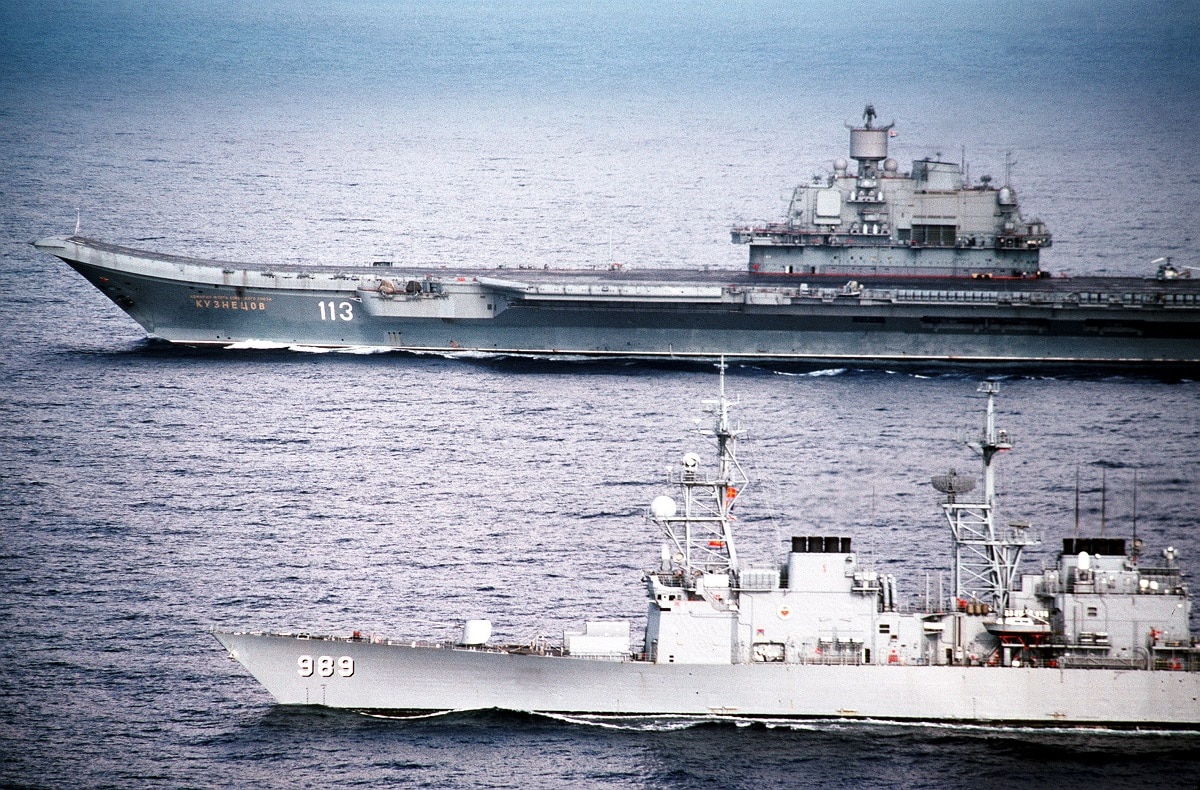It’s a punchline to many jokes, well, at least in defense circles, that it. Russia’s only aircraft carrier, the Admiral Kuznetsov, can barely keep it together. It’s suffered deadly electrical fires, bad airplane landings, a sunk drydock, and several breakdowns. This unlucky ship has endured a lifetime of hardship. It has been undergoing a refit and will perhaps be ready for sea trials in 2022. But the Russians are not exactly known for meeting deadlines when it comes to shipbuilding and Admiral Kuznetsov could be delayed well past next year.
What a Flagship…
Despite all these troubles, the Admiral Kuznetsov is still the Russian navy’s flagship. Perhaps signaling its bad fortune, the ship has been renamed three different times. It’s not nuclear-powered and burns a heavy sour fuel called Mazut that sends an embarrassing amount of smelly, black smoke into the air.
The Russians had grand plans for Admiral Kuznetsov. Built in Ukraine, it started construction in 1981, but it wasn’t finished until 1996. Instead of vertical take-off and landing aircraft, the Admiral Kuznetzov had real carrier-based airplanes such as then-new Su-33 and older Su-25s fighters. The deck, however, is an outdated ski-jump model. The Admiral Kuznetzov was well-armed when it entered service with 12 anti-ship cruise missiles and 190 surface-to-air missiles.
What an Unlucky Bucket of Bolts
But the ship was cursed.
It broke down so many times it had to have a repair ship and tugboats accompany it at sea. The mishaps kept coming. In 2009, off the coast of Turkey, a fire killed a sailor. Then the same year an oil leak sent 300 metric tons of oil into the sea off Ireland. Its only combat deployment to Syria in 2016 went terribly. Two fighters were lost when they failed to be arrested upon landing because of faulty arresting wires. The rest of the planes had to be transferred to Khmeimim Air Base in Syria, which defeated the purpose of having a carrier in the first place.
More Mishaps Are Deadly
It was undergoing yet more repairs in 2018, when a strange accident sent the drydock to the bottom of the sea and a 70-ton crane collapsed and damaged the flight deck. This killed one worker and injured four more. Two other workers died in 2019 due to a fire in the engine room after a welding accident. 11 others were injured during that incident. Ten years ago, the U.S. Navy even thought the carrier would sink in the Mediterranean.
It’s docked now for modernization. The MiG-29K carrier-variant will eventually take over for the Su-33. The wing will be increased from 24 to 26 airplanes. New cruise missiles will be deployed. Advanced electronics and communications systems will be added. This is all supposed to happen by next year.
How Does Russia Not Have a Serviceable Aircraft Carrier?
The saga of Admiral Kuznetsov is a strange story. This is a country that is updating its military constantly with many modern ICBMs, along with stealth fighters and drones. It excels at political and ambiguous warfare. It annexed Crimea without firing a shot. NATO is worried it could invade the Baltics.
Despite all of these advancements, shipbuilding is poor. Vladimir Putin is usually at the forefront of all the Russian military achievements, yet he has allowed this aircraft carrier to become a laughingstock. It is currently out of service and will not likely be ready next year. There is no money or engineering prowess to build a new carrier, so the Russians are stuck with the cursed Admiral Kuznetsov. The few completed warships are all based on old Soviet designs. The main problem is that Russia depends on other countries to supply components of its warships. Until the Kremlin solves this domestic defense industrial problem, the Russian navy will suffer.

Admiral Kuznetsov in the waters south of Italy with USS Deyo, foreground, steaming off her port side.
1945’s new Defense and National Security Editor, Brent M. Eastwood, PhD, is the author of Humans, Machines, and Data: Future Trends in Warfare. He is an Emerging Threats expert and former U.S. Army Infantry officer.

